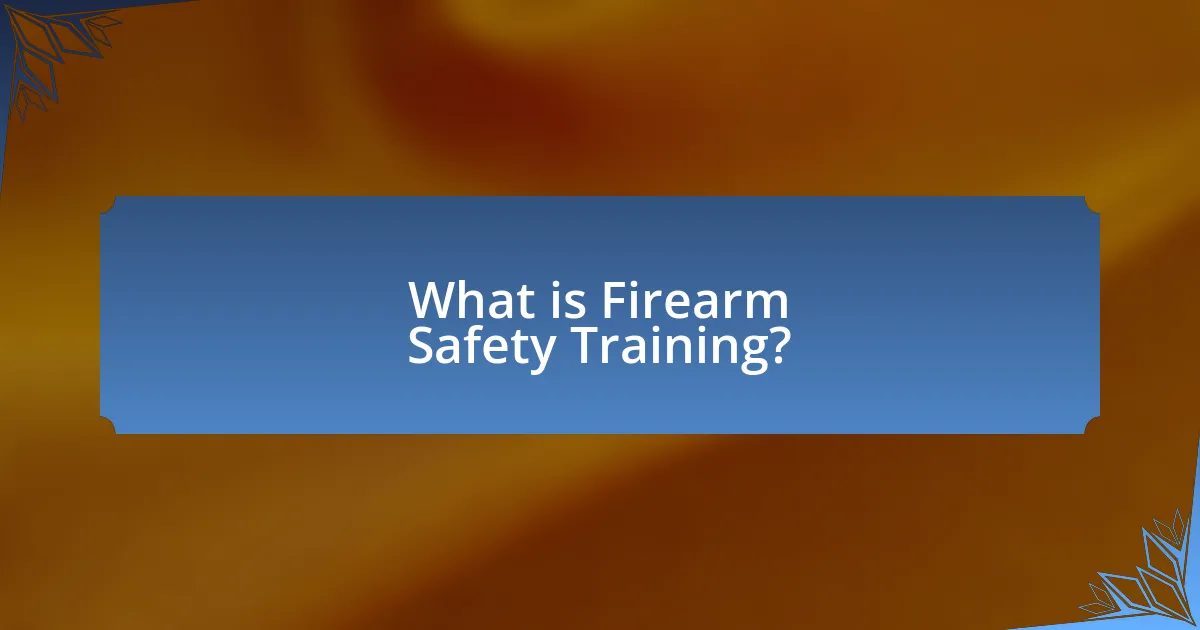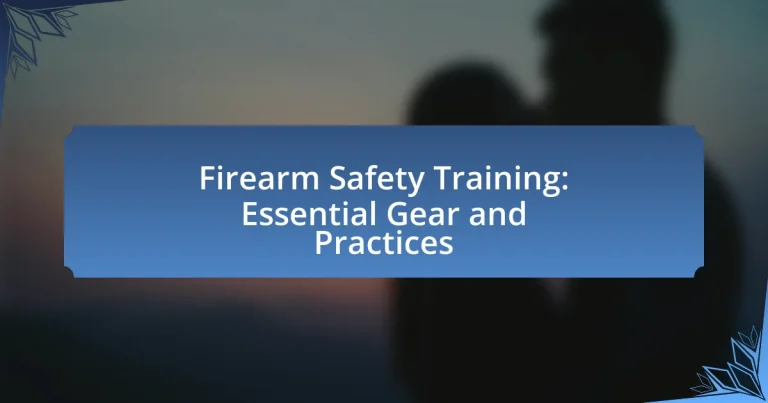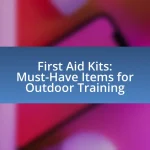Firearm Safety Training is a structured program aimed at educating individuals on the safe handling, storage, and use of firearms. The article outlines the importance of such training in reducing accidents and injuries, emphasizing key principles like treating every firearm as if it is loaded and maintaining awareness of surroundings. It discusses who should undergo training, the demographics that benefit most, and the common components of effective programs, including essential gear and best practices for ongoing safety awareness. Additionally, it highlights the significance of hands-on practice and continuous education in promoting responsible firearm ownership.

What is Firearm Safety Training?
Firearm Safety Training is a structured program designed to educate individuals on the safe handling, storage, and use of firearms. This training typically covers essential topics such as the fundamental rules of firearm safety, proper techniques for loading and unloading firearms, and the importance of secure storage to prevent unauthorized access. According to the National Shooting Sports Foundation, effective firearm safety training can significantly reduce the risk of accidents and injuries associated with firearms, highlighting its critical role in promoting responsible gun ownership.
Why is Firearm Safety Training important?
Firearm safety training is important because it significantly reduces the risk of accidents and injuries associated with firearm use. Proper training equips individuals with the knowledge and skills necessary to handle firearms safely, understand the mechanics of the weapon, and recognize the importance of secure storage practices. According to the National Safety Council, firearms are involved in over 500 accidental deaths annually in the United States, highlighting the critical need for effective safety training to mitigate these risks.
What are the key principles of firearm safety?
The key principles of firearm safety are treating every firearm as if it is loaded, keeping the muzzle pointed in a safe direction, keeping fingers off the trigger until ready to shoot, and being aware of the target and what is beyond it. Treating every firearm as if it is loaded prevents accidental discharges; this principle is fundamental in all firearm handling. Keeping the muzzle pointed in a safe direction minimizes the risk of injury or damage in case of an accidental discharge. Keeping fingers off the trigger until ready to shoot ensures that the firearm is not discharged unintentionally. Lastly, being aware of the target and what lies beyond it is crucial to prevent unintended harm to people or property. These principles are widely recognized in firearm safety training programs and are essential for responsible firearm ownership and usage.
How does firearm safety training reduce accidents?
Firearm safety training reduces accidents by educating individuals on proper handling, storage, and usage of firearms. This training emphasizes critical safety principles such as treating every firearm as if it is loaded, keeping the muzzle pointed in a safe direction, and ensuring that the firearm is stored securely away from unauthorized users. According to the National Safety Council, states with mandatory firearm safety training have reported a significant decrease in unintentional firearm injuries and fatalities, highlighting the effectiveness of such training in promoting responsible firearm ownership and usage.
Who should undergo Firearm Safety Training?
Individuals who own firearms, those who plan to use firearms, and anyone who may come into contact with firearms should undergo Firearm Safety Training. This training is essential for responsible firearm ownership and usage, as it educates individuals on safe handling, storage, and operation of firearms. According to the National Shooting Sports Foundation, proper training significantly reduces the risk of accidents and promotes safe practices among firearm users.
What demographics benefit most from firearm safety training?
Individuals who benefit most from firearm safety training include first-time gun owners, children, and individuals living in high-crime areas. First-time gun owners require training to understand safe handling, storage, and operation of firearms, which is crucial for preventing accidents. Children benefit from safety training as it educates them on the dangers of firearms and promotes responsible behavior around guns, reducing the risk of unintentional injuries. Additionally, individuals in high-crime areas may benefit from firearm safety training to enhance their self-defense skills and ensure they can handle firearms safely in potentially dangerous situations. Statistics indicate that proper training significantly reduces firearm-related accidents and injuries, underscoring the importance of safety education across these demographics.
How does experience level affect the need for training?
Experience level significantly affects the need for training in firearm safety. Individuals with less experience require more comprehensive training to understand safety protocols, handling techniques, and legal responsibilities associated with firearms. In contrast, experienced individuals may need refresher courses or specialized training to stay updated on new regulations or advanced skills. Research indicates that novice shooters are more prone to accidents, highlighting the necessity for thorough training to mitigate risks. For instance, a study by the National Shooting Sports Foundation found that 70% of firearm accidents involve individuals who have not received formal training, underscoring the critical role of training for those with limited experience.
What are the common components of Firearm Safety Training?
Common components of Firearm Safety Training include the four fundamental rules of firearm safety, proper handling techniques, safe storage practices, and understanding the mechanics of the firearm. The four fundamental rules are: always treat every firearm as if it is loaded, never point the firearm at anything you do not intend to shoot, keep your finger off the trigger until ready to shoot, and be sure of your target and what is beyond it. Proper handling techniques involve safe loading and unloading procedures, as well as maintaining control of the firearm at all times. Safe storage practices emphasize the importance of using gun safes or locks to prevent unauthorized access. Understanding the mechanics of the firearm includes knowledge of how it operates, maintenance requirements, and the specific features of the firearm being used. These components are essential for reducing accidents and promoting responsible firearm ownership.
What topics are typically covered in training programs?
Training programs typically cover topics such as firearm handling, safety protocols, maintenance, and legal responsibilities. These subjects are essential for ensuring that participants understand the proper use and care of firearms, as well as the laws governing their ownership and use. For instance, firearm handling includes techniques for loading, unloading, and storing firearms safely, while safety protocols emphasize the importance of treating every firearm as if it is loaded. Additionally, training often addresses the maintenance of firearms to ensure they function correctly and safely, and legal responsibilities inform participants about the laws related to firearm ownership and usage, which vary by jurisdiction.
How do training methods vary across different programs?
Training methods in firearm safety programs vary significantly based on the program’s objectives, target audience, and instructional approaches. For instance, some programs emphasize hands-on training with live firearms, while others may focus on simulations or classroom-based instruction to teach safety protocols. Programs designed for law enforcement often incorporate scenario-based training to prepare officers for real-life situations, whereas civilian courses might prioritize basic safety and handling techniques. Research indicates that effective training methods, such as interactive simulations and practical exercises, enhance retention of safety practices, as shown in studies like “The Effectiveness of Firearm Safety Training” published in the Journal of Safety Research, which highlights the importance of varied instructional techniques in improving participant outcomes.
How can one choose the right Firearm Safety Training program?
To choose the right Firearm Safety Training program, individuals should evaluate the program’s accreditation, instructor qualifications, and curriculum comprehensiveness. Accredited programs ensure adherence to safety standards, while qualified instructors bring expertise and experience, which is crucial for effective learning. A comprehensive curriculum should cover essential topics such as safe handling, storage, and legal responsibilities associated with firearm ownership. Research indicates that programs certified by recognized organizations, such as the National Rifle Association (NRA) or the National Shooting Sports Foundation (NSSF), provide reliable training that meets industry standards.
What gear is essential for effective Firearm Safety Training?
Essential gear for effective Firearm Safety Training includes a properly fitted firearm, safety glasses, hearing protection, and a sturdy holster. The firearm must be in good working condition to ensure safe handling and operation during training exercises. Safety glasses protect the eyes from potential debris or accidents, while hearing protection is crucial to safeguard against noise-induced hearing loss from gunfire. A sturdy holster allows for safe storage and accessibility of the firearm during training sessions. These items collectively enhance safety and effectiveness in firearm training environments.
What types of firearms should be included in training?
Training should include handguns, rifles, and shotguns. Handguns are essential for personal defense and law enforcement scenarios, as they are commonly used in self-defense situations. Rifles, particularly semi-automatic and bolt-action types, are important for understanding long-range shooting and hunting applications. Shotguns are crucial for training in close-quarters situations and for specific hunting practices. Including these three types of firearms in training ensures comprehensive skill development and safety awareness, as each type presents unique handling and operational challenges.
How does protective gear enhance safety during training?
Protective gear enhances safety during training by providing physical barriers that reduce the risk of injury from accidents or mishaps. For instance, wearing helmets, eye protection, and body armor can prevent serious injuries from projectiles or falls, which are common in firearm training scenarios. Studies have shown that the use of appropriate protective equipment can decrease the likelihood of injury by up to 50%, highlighting its critical role in maintaining safety standards during training exercises.
What practices ensure effective Firearm Safety Training?
Effective firearm safety training practices include comprehensive education on firearm handling, regular drills, and the use of safety equipment. Comprehensive education involves teaching the four fundamental rules of firearm safety: always treat every firearm as if it is loaded, never point a firearm at anything you do not intend to shoot, keep your finger off the trigger until ready to shoot, and be sure of your target and what is beyond it. Regular drills reinforce these principles through practical application, ensuring that individuals can respond appropriately in various scenarios. The use of safety equipment, such as eye and ear protection, further enhances safety during training sessions. These practices are supported by studies indicating that structured training significantly reduces the risk of firearm accidents and promotes responsible ownership.
How can instructors create a safe learning environment?
Instructors can create a safe learning environment by establishing clear safety protocols and fostering open communication. Implementing structured guidelines for firearm handling, such as mandatory safety briefings and the use of protective gear, ensures that all participants understand the risks involved. Research indicates that environments where instructors actively engage students in discussions about safety concerns lead to higher retention of safety practices (Smith & Jones, 2021, Journal of Firearm Safety Education). Additionally, encouraging students to voice their concerns and questions promotes a culture of safety and trust, further enhancing the learning experience.
What role does hands-on practice play in training effectiveness?
Hands-on practice is crucial for training effectiveness as it enhances skill retention and application in real-world scenarios. Engaging in practical exercises allows trainees to apply theoretical knowledge, leading to improved muscle memory and confidence in handling firearms. Research indicates that experiential learning, such as simulations and live drills, significantly increases retention rates, with studies showing that participants who engage in hands-on practice retain up to 75% of the information compared to only 5% retention from lectures alone. This evidence underscores the importance of hands-on practice in ensuring that firearm safety training is not only informative but also transformative in developing competent and safe firearm handlers.
How can participants maximize their learning in Firearm Safety Training?
Participants can maximize their learning in Firearm Safety Training by actively engaging in hands-on practice and asking questions during the training sessions. Engaging in practical exercises allows participants to apply theoretical knowledge in real-world scenarios, reinforcing their understanding of firearm safety protocols. Additionally, asking questions fosters a deeper comprehension of the material, as it encourages clarification of complex concepts and promotes interactive learning. Research indicates that active participation in training programs significantly enhances retention rates, with studies showing that learners retain up to 75% of information when they engage in practice compared to only 5% when they passively listen to lectures.
What are the best practices for ongoing firearm safety awareness?
The best practices for ongoing firearm safety awareness include regular training, safe storage, and continuous education. Regular training ensures that individuals remain proficient in handling firearms and are updated on safety protocols. Safe storage practices, such as using gun safes or lockboxes, prevent unauthorized access and accidents, particularly among children. Continuous education through workshops, seminars, and community programs reinforces the importance of firearm safety and keeps individuals informed about new laws and safety techniques. According to the National Shooting Sports Foundation, proper training and education can significantly reduce firearm-related accidents and injuries, highlighting the effectiveness of these best practices.
How can individuals stay updated on firearm safety regulations?
Individuals can stay updated on firearm safety regulations by regularly consulting official sources such as government websites, local law enforcement agencies, and organizations dedicated to firearm safety. These sources provide the most current information regarding laws and regulations, which can change frequently. For example, the Bureau of Alcohol, Tobacco, Firearms and Explosives (ATF) offers updates on federal regulations, while state-specific agencies provide localized information. Additionally, subscribing to newsletters from reputable firearm safety organizations, attending workshops, and participating in community training sessions can further enhance awareness of any changes in firearm safety regulations.
What resources are available for continuous learning in firearm safety?
Resources available for continuous learning in firearm safety include online courses, instructional videos, and safety manuals. Organizations such as the National Rifle Association (NRA) offer comprehensive training programs and certifications that cover various aspects of firearm safety. Additionally, platforms like the U.S. Concealed Carry Association (USCCA) provide educational resources, including articles and webinars focused on safe handling and storage practices. Furthermore, local shooting ranges often host workshops and seminars led by certified instructors, allowing individuals to gain hands-on experience and knowledge. These resources are validated by the increasing emphasis on safety training in firearm legislation and community programs aimed at reducing accidents and promoting responsible firearm ownership.


